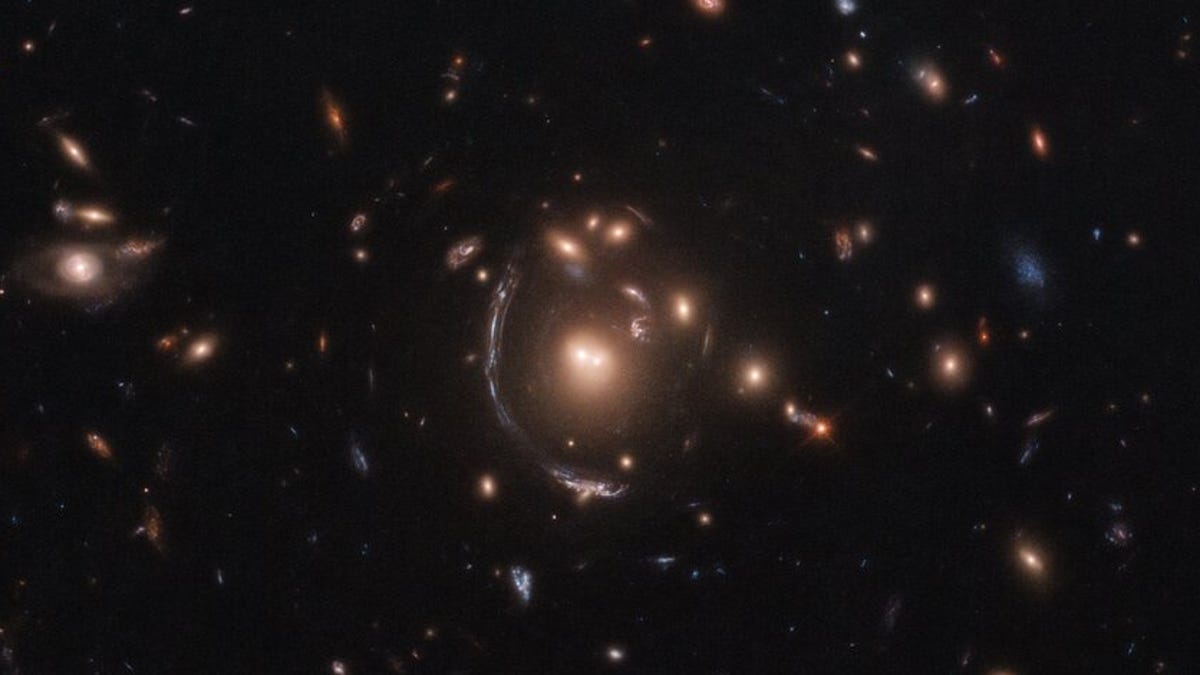Einstein's Mind-Bending Theory Helps Scientists Analyze a Dead Star
Gravitational microlensing allows astronomers to make a historical measurement of a white dwarf's mass.

This 2020 NASA/ESA Hubble Space Telescope image features the galaxy LRG-3-817, its image distorted by the effects of gravitational lensing. As such, it appears as a long arc to the left of the central galaxy cluster.
A similar effect was tapped for Hubble's recent white dwarf measurements.
Astronomers announced Thursday that they used NASA's Hubble Space Telescope to directly measure the mass of a star's corpse for the first time. But here's the kicker: that they did it by tapping into a mind-bending cosmic effect called gravitational microlensing, predicted by Albert Einstein's general relativity theory more than a century ago.
This Hubble achievement marks the very first time such an effect has been used to measure a single, isolated star other than our very own sun.
I'll get into the microlensing bit in a moment, but here are some quick stats about the white dwarf's historic measurements.
First of all, it's named LAWD 37. Insert "oh lawd he comin'" cat meme. Sorry.
Second, this lonely stellar body, which is the superhot, surviving core of a burned-out, sunlike star, appears to be 56% the mass of our sun, according to Hubble's observations. That's quite a relief because that figure, per the research team, agrees with previous theoretical predictions about LAWD 37 and solidifies many of our current theories about white dwarf structure and composition. And understanding white dwarves is crucial to our understanding of the universe.
"White dwarfs give us clues into how stars evolve -- someday our own star will end up as a white dwarf," Peter McGill, a postdoctoral scholar at UC Santa Cruz and lead author of a study on the measurements published in Monthly Notices of the Royal Astronomical Society, said in a statement.
Because this white dwarf in particular is so close to us at about 15 light-years away, McGill explains, we've got lots of data on it. "But the missing piece of the puzzle has been a measurement of its mass." Thankfully, though, we now have that piece too.
Which is where Einstein's theory comes in.
What is gravitational microlensing?
Since its genesis in the early 1900s, scientists have remained absolutely enthralled by Einstein's astonishing theory of general relativity -- an idea that settles itself on the strange premise that our cosmic expanse is physically woven together with tangible threads of space and time.
Not only is general relativity yet to be disproven, despite decades of experts trying to find a loophole, but it also explains some of the weirdest things to happen in our universe. Things like black hole collisions that send gravitational waves reverberating across space, and time ticking differently in Earth's orbit than on its soil.
But one of astronomers' favorite general relativity effects is that light in the distant universe appears to bend, twist and warp when traveling through the presence of extreme gravity pools generated by massive compact objects such as galaxy clusters. It's called gravitational lensing -- and on a smaller scale, gravitational microlensing.
Gravitational lensing is an important phenomenon for astronomy because whatever's emitting those warped beams of light (a star, for instance) can appear magnified to an observer who'd otherwise be unable to see it. On the flip side, you can deduce information about whatever stuff is causing beams of light to warp by working backward.
And the latter is precisely what McGill and fellow researchers took advantage of.
This artist's illustration shows how the gravity of a white dwarf star warps space and bends the light of a distant star behind it.
To begin, the astronomers used the European Space Agency's Gaia satellite -- a device presently trying to create a wondrously detailed map of the Milky Way galaxy -- to figure out where Hubble should look in search of LAWD 37 during a likely gravitational microlensing event.
Then they watched as light from a background star passed behind LAWD 37, its light warped by Hubble's point of interest.
The team eventually figured out vital parameters of how the background star's light changed in the presence of LAWD 37 and, through the art of deduction, learned what type of star mass would yield such changes. There you have it.
This graphic shows how microlensing was used to measure the mass of a white dwarf star. The inset box plots how the dwarf passed in front of a background star in 2019. The wavy blue line traces the dwarf's apparent motion across the sky as seen from Earth.
"The precision of LAWD 37's mass measurement allows us to test the mass-radius relationship for white dwarfs," McGill said. "This means testing the properties of matter under the extreme conditions inside this dead star."
In 1919, just a few years after Einstein published a paper outlining the general relativity theory, two British astronomers used this sort of lensing effect to similarly observe the sun's mass during a solar eclipse. That was a huge moment because it was considered the first-ever experimental proof of relativity, according to NASA -- but it remained unclear at the time whether anyone would be able to "gravitationally lens" again.
"These events are rare, and the effects are tiny," McGill said. "For instance, the size of our measured effect is like measuring the length of a car on the moon as seen from Earth, and is 625 times smaller than the effect measured at the 1919 solar eclipse."
Going forward, the team wants to continue using Gaia to predict when possible gravitational microlensing events could help them obtain as many starry mass measurements as possible. In fact, principal Hubble investigator and co-author of the study Kailash Sahu is already working on observing another white dwarf, named LAWD 66, with NASA's trailblazing James Webb Space Telescope.
Considering how powerful the JWST is, I for one can't wait to see the next level of gravitational microlensing unfold.

